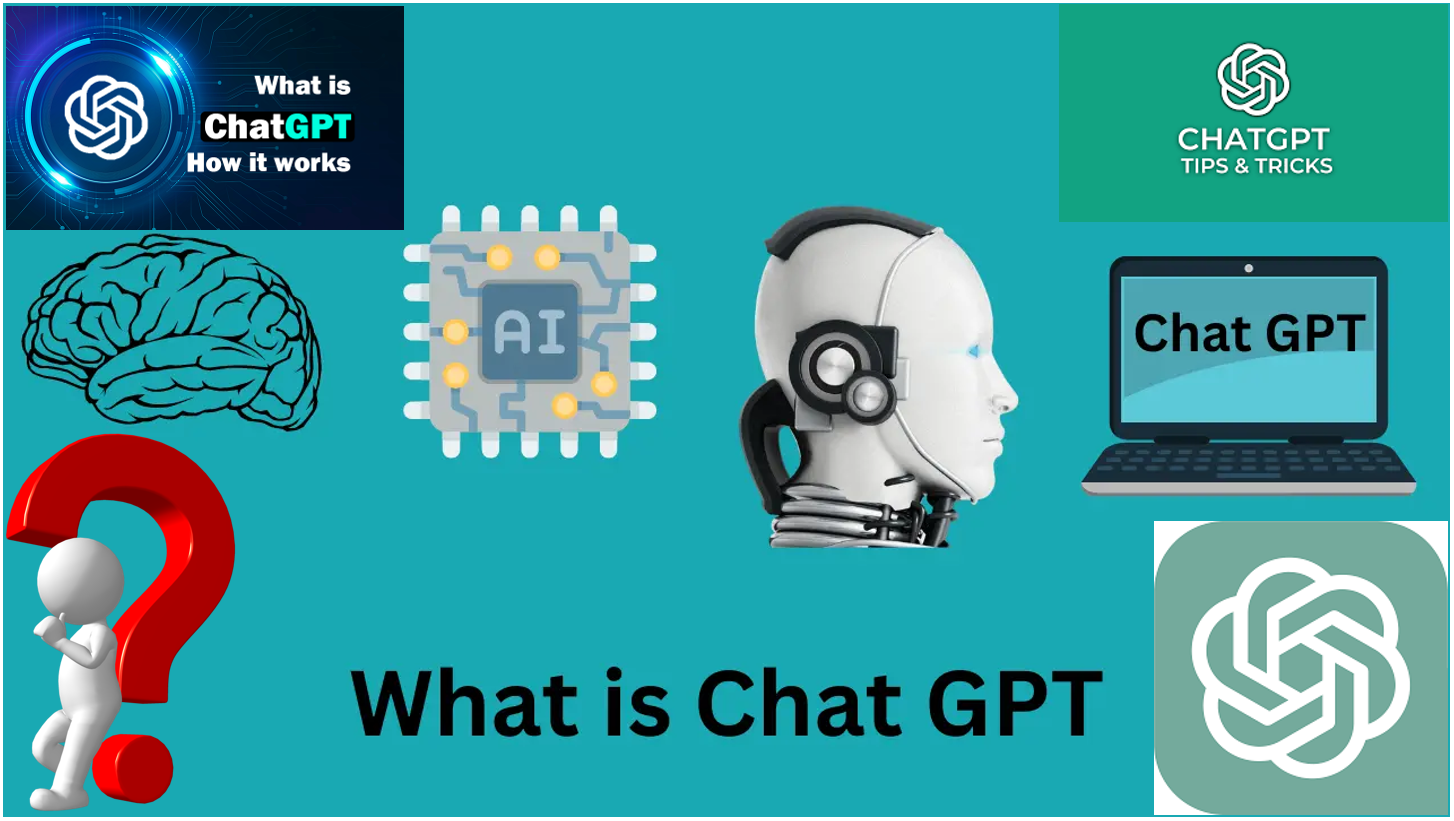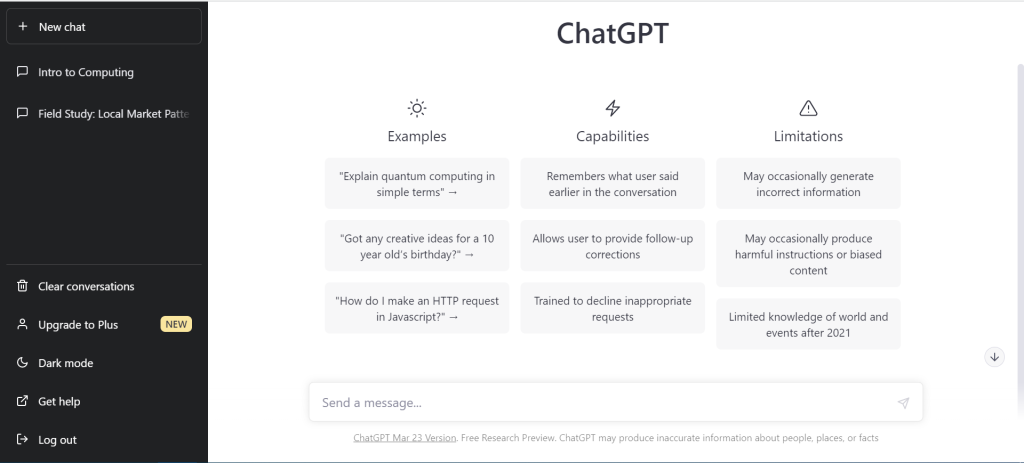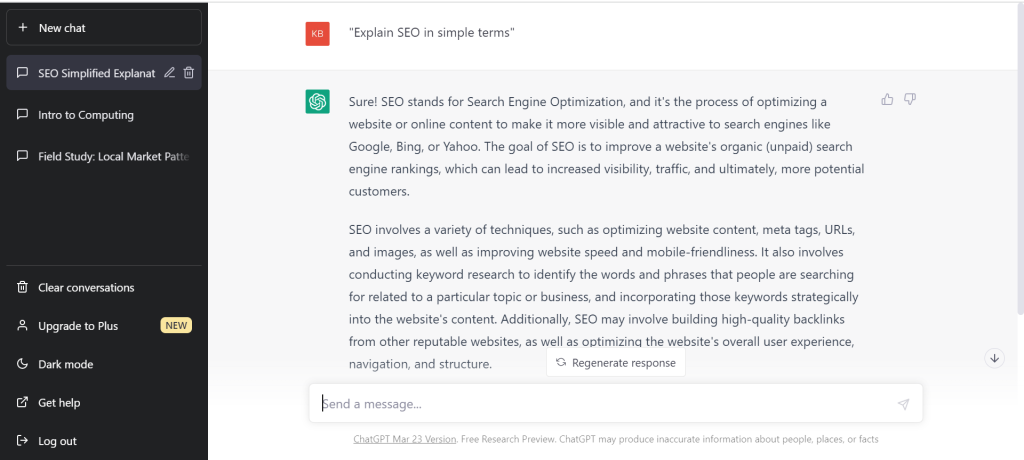
What is ChatGPT? ChatGPT is a language model developed by OpenAI, which is a leading artificial intelligence research organization. ChatGPT is based on the GPT (Generative Pre-trained Transformer) architecture, which is a type of deep neural network that has been trained on large amounts of text data to generate human-like text responses to a wide range of prompts.
ChatGPT is designed for conversational interactions, where users can provide prompts or questions, and the model generates text-based responses based on its training data. It can be used for a variety of tasks, such as answering questions, providing information, generating text, and engaging in interactive conversations.
ChatGPT is not a human, but rather an AI model that generates text responses based on patterns learned from the vast amount of text data it has been trained on. It does not have real-world knowledge, experiences, or emotions, and its responses are solely based on the patterns it has learned from its training data.
It’s important to note that ChatGPT, like other language models, may not always be perfect and its responses should be critically evaluated for accuracy and reliability. It’s always a good practice to verify information obtained from language models like ChatGPT with reliable and trusted sources before making decisions or conclusions based on the generated text.


Background of ChatGPT
ChatGPT is developed by OpenAI, which is a leading artificial intelligence research organization based in San Francisco, California, USA. OpenAI was founded in 2015 with the mission to ensure that artificial general intelligence (AGI) benefits all of humanity. AGI refers to highly autonomous systems that can outperform humans in most economically valuable work.
OpenAI has a team of researchers, engineers, and data scientists who work on developing cutting-edge AI technologies, including language models like ChatGPT. ChatGPT is based on the GPT (Generative Pre-trained Transformer) architecture, which is a type of deep neural network that has been trained on large amounts of text data from the internet to learn the patterns of human language and generate text-based responses.


The development of ChatGPT involves a continuous process of research, experimentation, and refinement. OpenAI periodically releases updated versions of its language models, including ChatGPT, to improve their capabilities and performance based on feedback from users and ongoing research advancements.
OpenAI’s language models, including ChatGPT, have been used for a wide range of applications, such as answering questions, generating text, providing language-based services, and engaging in interactive conversations. They have been adopted by various organizations and individuals for their AI-based applications and use cases.
OpenAI is committed to advancing the field of artificial intelligence and ensuring that its technologies are developed and deployed responsibly, with consideration for ethical implications, fairness, transparency, and societal impact. The background of ChatGPT is rooted in OpenAI’s mission to develop advanced AI technologies that benefit humanity and contribute to the field of artificial intelligence research.
How Does ChatGPT Work?
ChatGPT is a language model developed by OpenAI that uses deep learning techniques, specifically a type of neural network called a transformer model, to generate text-based responses in a conversational manner. Here’s a high-level overview of how ChatGPT works:
- Pre-training: ChatGPT is pre-trained on a large corpus of text data from the internet, which helps it learn the statistical patterns and structures of human language. During pre-training, the model learns to predict the next word in a sentence, which helps it learn grammar, syntax, and word usage.
- Fine-tuning: After pre-training, ChatGPT is fine-tuned on a narrower dataset that is carefully generated with the help of human reviewers who follow certain guidelines. This fine-tuning process helps the model learn to generate appropriate responses in a conversational manner and align with OpenAI’s desired behavior.
- Input processing: When a user inputs a message to ChatGPT, the model tokenizes the text into smaller chunks, such as words or subwords, and represents them as numerical vectors.
- Dialogue management: ChatGPT maintains a context window of previous messages in the conversation, allowing it to understand the conversation’s context and generate responses accordingly. It uses the context window to keep track of the ongoing conversation and generates a response that is relevant to the input message and the conversation history.
- Text generation: Once the input message is processed and the conversation context is considered, ChatGPT generates a response using its pre-trained language model. The response is then decoded from numerical vectors back into text, and the generated text is sent as the model’s response to the user.
- Iterative process: ChatGPT engages in an iterative conversation with users, receiving input messages, processing them, generating responses, and updating the context window based on the conversation history. This allows for dynamic and interactive conversations with the model.
It’s worth noting that ChatGPT is a generative model, which means it generates text based on patterns learned from the data it was trained on and does not have an explicit understanding of the meaning of words or the context of the conversation. It’s also important to consider the limitations and potential biases of language models like ChatGPT in terms of accuracy, context-sensitivity, and ethical use.
What is ChatGPT?
Advantages of ChatGPT
There are several advantages of using ChatGPT, which is a language model developed by OpenAI:
- Wide range of applications: ChatGPT can be used for a wide range of tasks, including answering questions, generating text, providing language-based services, and engaging in interactive conversations. It has the potential to be applied in various industries and domains, such as customer service, content generation, language translation, and more.
- Scalability and efficiency: ChatGPT can process large amounts of text data and generate responses quickly, making it suitable for real-time interactions and high-volume applications. It can handle multiple prompts and queries simultaneously, making it efficient for handling large-scale interactions.
- Language capabilities: ChatGPT has been trained on large amounts of text data from the internet, which gives it a broad understanding of human language. It can generate text responses that are coherent, contextually relevant, and grammatically correct, making it useful for generating human-like text.
- Continuous learning and improvement: ChatGPT is based on the GPT architecture, which is designed to be continuously updated and improved. OpenAI periodically releases updated versions of its language models, including ChatGPT, to enhance their capabilities and performance based on user feedback and ongoing research advancements.
- Flexibility and adaptability: ChatGPT can be fine-tuned on specific domains or tasks, making it adaptable to different use cases and industries. It can be customized to suit specific requirements, allowing for flexibility in its application across various domains.
- Accessibility: ChatGPT, like other language models, is accessible online, which makes it easily available for users to interact with and utilize in their applications. It can be integrated into different platforms and applications, making it accessible to a wide range of users.
- Cost-effective: ChatGPT can be a cost-effective solution for many language-based tasks compared to developing custom language models from scratch. It provides a pre-trained, ready-to-use solution that can be fine-tuned for specific use cases, saving time and resources in model development.
It’s worth noting that while ChatGPT has many advantages, it also has limitations, such as potential biases in its responses, lack of real-world experiences, and limitations in handling nuanced or complex queries. It’s important to use ChatGPT, or any other language model, judiciously and critically evaluate its outputs for accuracy and reliability.
What is ChatGPT?
Disadvantages of ChatGPT
While ChatGPT has many advantages, it also has some limitations and potential disadvantages, including:
- Inaccuracy and Errors: ChatGPT, like other language models, may generate responses that are inaccurate, misleading, or incorrect. It may not always provide reliable information, as it relies on the data it has been trained on, which may not be completely accurate or up-to-date.
- Bias in Responses: ChatGPT may exhibit biases in its responses, as it learns from large amounts of text data from the internet, which can contain biases present in the data. This can result in biased or unfair outputs, perpetuating societal biases related to race, gender, religion, and other sensitive attributes.
- Lack of Contextual Understanding: ChatGPT may struggle to fully understand the context of a conversation or query, leading to inaccurate or irrelevant responses. It may not always interpret nuances, tone, or sarcasm accurately, which can result in misleading or inappropriate responses.
- Limited Real-world Experiences: ChatGPT is a language model trained on text data, and does not have real-world experiences. It lacks actual knowledge and understanding of the world beyond what it has been trained on, which can limit its ability to provide accurate or comprehensive responses in certain situations.
- Ethical Concerns: The use of language models like ChatGPT raises ethical concerns related to privacy, security, and data handling. The interactions with ChatGPT may involve sharing personal or sensitive information, and it’s important to consider the ethical implications of using such models in different contexts.
- Dependence on Internet Connectivity: ChatGPT requires internet connectivity to function, as it relies on cloud-based infrastructure for processing. This can be a limitation in situations where internet access is limited or unavailable, making ChatGPT inaccessible in certain scenarios.
- Overreliance on AI-generated Content: Relying solely on AI-generated content, such as using ChatGPT for content generation, can lead to a lack of human creativity, originality, and uniqueness in the content. It’s important to strike a balance between human-generated and AI-generated content to maintain authenticity and originality.
It’s crucial to recognize these limitations and use ChatGPT, or any other language model, judiciously, and critically evaluate its outputs for accuracy, reliability, and ethical implications. Human oversight and validation are essential to ensure the quality and appropriateness of the responses generated by ChatGPT.
What is ChatGPT?
How to get the best results on ChatGPT?
Here are some tips on how to get the best results when using ChatGPT or any other language model:
- Be Clear and Specific: Provide clear and specific input when interacting with ChatGPT. Clearly state your query or request, and provide relevant details to help the model understand your intent accurately.
- Experiment with Prompting: Experiment with different prompts to guide the model towards the desired output. You can start with a clear instruction or question, or provide some context to guide the model’s response.
- Iterate and Refine: If the initial output from ChatGPT is not satisfactory, iterate and refine your query. You can try rephrasing or providing additional information to improve the quality and relevance of the responses.
- Use System Messages: Utilize system messages to gently guide the model’s behavior. System messages are messages that start with a predefined phrase like “You are ChatGPT, a large language model trained by OpenAI,” which can help set the context and expectations for the model’s responses.
- Check for Accuracy: Always double-check the accuracy and reliability of the information provided by ChatGPT. Verify the information from trusted sources to ensure its accuracy before using it for critical decision-making.
- Be Mindful of Bias: Keep in mind that ChatGPT, like other language models, may have biases in its responses. Be mindful of potential biases and critically evaluate the outputs for fairness and accuracy.
- Use Human Judgment: Remember that ChatGPT is a tool and not a substitute for human judgment. Always use your own critical thinking skills and judgment to evaluate the information provided by ChatGPT and make informed decisions.
- Consider Privacy and Security: Be mindful of the information you share with ChatGPT or any other AI model. Avoid sharing sensitive or personal information unless necessary, and consider the privacy and security implications of using AI-generated content.
- Provide Feedback: If you encounter issues or inaccuracies with ChatGPT’s responses, provide feedback to the developers or administrators. Your feedback can help improve the model’s performance and accuracy over time.
By following these tips, you can enhance the effectiveness of using ChatGPT and get the best results based on your specific needs and requirements.
How do I access ChatGPT?
As an AI language model developed by OpenAI, ChatGPT can be accessed through various platforms and applications that integrate with the OpenAI API. Here are some ways to access ChatGPT:
- You can access ChatGPT by going to chat. OpenAI.com and logging in. If you’re on OpenAI’s website, you can log in to your account, then scroll down until you see ChatGTP on the bottom left corner of the page, and click on it to start chatting.
- OpenAI Playground: You can access ChatGPT for free through the OpenAI Playground, which is a web-based interface that allows you to interact with the model and generate text.
- OpenAI API: OpenAI provides an API (Application Programming Interface) that allows developers to integrate ChatGPT into their own applications, products, or services. To use the API, you need to sign up for an API key and follow the documentation and guidelines provided by OpenAI.
- OpenAI partners and applications: ChatGPT may also be available through third-party applications or platforms that have integrated with the OpenAI API. These could include chatbots, virtual assistants, or other AI-powered applications that utilize ChatGPT for generating text-based responses.
It’s important to note that different access methods may have different usage policies, terms of service, and costs associated with them, depending on the platform or application you use. Be sure to review and follow the terms and conditions set by the respective providers to ensure compliance and proper usage.
Search Engines vs Open AIs?
Search engines and OpenAI are different entities that serve distinct purposes and operate in different ways:
- Search engines: Search engines, such as Google, Bing, and Yahoo, are online tools that allow users to search the internet and retrieve information from the vast amount of data available online. Search engines use algorithms to index and rank web pages based on various factors, such as relevance, authority, and popularity, to provide users with search results.
- OpenAI: OpenAI is an artificial intelligence research organization that develops and promotes advanced AI technologies, including language models like ChatGPT. OpenAI’s language models are trained on large datasets to generate human-like text responses to a wide range of prompts, and they are not specifically designed for web searching or retrieving information from the internet.
While search engines are designed to provide users with a broad range of information from the internet based on their search queries, OpenAI’s language models, including ChatGPT, are trained to generate text-based responses based on the prompts given to them, without accessing the internet or external sources.
In summary, search engines are specialized tools for searching and retrieving information from the internet, while OpenAI’s language models are AI technologies designed to generate text-based responses based on the prompts provided, without accessing the internet or external sources for information retrieval.
Can I trust the information on Search Engines, Like Google?
While Google is a widely used search engine that provides access to a vast amount of information, it’s important to understand that not all information on the internet is reliable or accurate, including information found on Google or any other search engine. The information on the internet can vary in quality, credibility, and accuracy, as anyone can publish content online.
When using Google or any other search engine, it’s essential to critically evaluate the sources of information and consider multiple perspectives to determine their reliability. Here are some tips for assessing the credibility of information found online:
- Verify the source: Check the credibility of the website or source providing the information. Is it a reputable organization, academic institution, government agency, or established news outlet? Look for information about the author or organization, their expertise, and any potential biases.
- Cross-reference information: Try to corroborate the information with multiple sources. If the same information is consistently reported by multiple reputable sources, it is more likely to be reliable.
- Fact-checking: Use fact-checking websites or organizations to verify the accuracy of the information. Fact-checkers can provide valuable insights into the credibility of news stories or claims.
- Date and currency: Check the publication or update date of the information. Outdated information may not be reliable, especially for rapidly changing topics or news events.
- Bias and perspective: Consider the potential bias or perspective of the information source. Does it present a balanced view, or does it have a clear agenda or bias?
Remember that critical thinking and skepticism are essential when evaluating information online. It’s always a good idea to cross-verify information from multiple reputable sources to ensure its accuracy and reliability.
What is the most reliable source?
There are several reliable sources for obtaining accurate and up-to-date information. Here are some commonly recognized ones:
- Government websites: Official websites of government entities, such as the White House, U.S. Department of State, or other government agencies, are generally reliable sources for information on government-related matters.
- Established news organizations: Reputable and well-known news organizations, such as BBC, CNN, Reuters, Associated Press (AP), The New York Times, and The Washington Post, are known for their journalistic integrity and fact-checking processes.
- Educational institutions: Universities, colleges, and academic institutions often provide reliable and well-researched information on a wide range of subjects.
- Peer-reviewed journals: Scholarly journals that go through a rigorous peer-review process are generally considered reliable sources for academic and scientific information.
- Official databases: Reliable databases such as those provided by government agencies, academic institutions, and research organizations can be good sources for factual data and research findings.
It’s always a good practice to cross-reference information from multiple sources to ensure accuracy and reliability. Additionally, fact-checking organizations like Snopes, FactCheck.org, and PolitiFact can also provide reliable information on fact-checking and debunking misinformation.
What is ChatGPT?
What is the future ChatGPT like?
As an AI language model, the future of ChatGPT is likely to involve ongoing development and improvements to enhance its capabilities, performance, and potential use cases. Here are some possible directions that the future of ChatGPT could take:
- Enhanced language understanding: Future versions of ChatGPT may have improved natural language understanding capabilities, allowing it to better interpret and respond to user queries and prompts in a more nuanced and accurate manner.
- Domain-specific customization: ChatGPT could potentially be customized or fine-tuned for specific domains or industries, such as healthcare, finance, or customer service, to provide more tailored and specialized responses for specific use cases.
- Multimodal capabilities: Future versions of ChatGPT may incorporate multimodal capabilities, enabling it to understand and generate text-based responses based on input from multiple modalities, such as text, images, audio, and video.
- Ethical and responsible AI: As the field of AI progresses, there may be increased focus on ethical and responsible AI development, including addressing biases, ensuring transparency and explainability, and adhering to robust safety measures to mitigate potential risks.
- Improved user interaction: Future iterations of ChatGPT may feature more interactive and dynamic conversations with users, allowing for back-and-forth interactions, context-aware responses, and more engaging conversational experiences.
- Expanded applications: ChatGPT could potentially find applications in various domains, such as customer service, content generation, language translation, virtual assistance, and more, as the technology evolves and new use cases emerge.
It’s important to note that the future of ChatGPT and other AI models is highly speculative and dependent on ongoing research, development, and innovation in the field of artificial intelligence. Predicting the exact capabilities and features of future versions of ChatGPT is challenging, and it’s likely that new advancements and possibilities may emerge as the technology evolves.
Free vs Plus ChatGPT Plans
OpenAI has a subscription plan called ChatGPT Plus, which offers additional benefits compared to the free access version of ChatGPT. Here are some key differences:
- Priority access: ChatGPT Plus subscribers receive priority access to ChatGPT, which means they may experience shorter wait times during peak usage periods.
- Faster response times: ChatGPT Plus subscribers may experience faster response times compared to the free version of ChatGPT.
- General access to new features and improvements: ChatGPT Plus subscribers get access to new features and improvements as they are released, providing an enhanced experience over time.
- Availability to customers outside of the United States: While ChatGPT free is available to users worldwide, initially ChatGPT Plus was limited to customers in the United States, but OpenAI expanded its availability to customers outside of the United States on February 10th, 2023.
Which other tools are like ChatGPT?
There are several other AI-powered language models and conversational AI tools that are similar to ChatGPT in terms of their capabilities and use cases. Some of these include:
- OpenAI’s GPT-3: GPT-3 (Generative Pre-trained Transformer 3) is one of the most advanced language models developed by OpenAI, the same organization behind ChatGPT. GPT-3 is known for its large-scale language generation capabilities and can be used for a wide range of applications, including text completion, text generation, question answering, language translation, and more.
- Microsoft’s DialoGPT: DialoGPT is a conversational variant of the GPT-2 model developed by Microsoft. It is designed specifically for engaging in conversations and can be used for tasks such as chatbots, virtual assistants, and customer service applications.
- Google’s Dialogflow: Dialogflow is a popular conversational AI platform developed by Google that allows developers to build chatbots, virtual assistants, and other conversational applications using natural language processing (NLP) and machine learning capabilities.
- IBM Watson Assistant: Watson Assistant is a conversational AI platform developed by IBM that enables businesses to build chatbots and virtual assistants to engage in natural language conversations with users across various channels.
- Facebook’s Wit.ai: Wit.ai is a natural language processing (NLP) platform developed by Facebook that allows developers to build conversational applications, including chatbots, virtual assistants, and more, using its powerful language understanding capabilities.
- Amazon Lex: Lex is a conversational AI service provided by Amazon Web Services (AWS) that enables developers to build chatbots and virtual assistants using natural language processing (NLP) capabilities, and integrate them with other AWS services.
These are just a few examples of the many AI-powered language models and conversational AI tools available in the market. The field of natural language processing (NLP) and conversational AI is rapidly evolving, and new tools and models may emerge over time, offering even more advanced capabilities and possibilities for building conversational applications.







[url=https://prednisone.today/]prednisone cost us[/url]
[url=http://doxycycline.run/]medication doxycycline 100mg[/url]
[url=https://amoxicillin.monster/]amoxicillin 500mg without prescription[/url]
[url=https://finasteride.cfd/]propecia buy canada[/url]
[url=http://lasix.world/]furosemide 40 mg cost[/url]